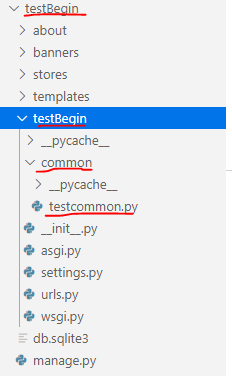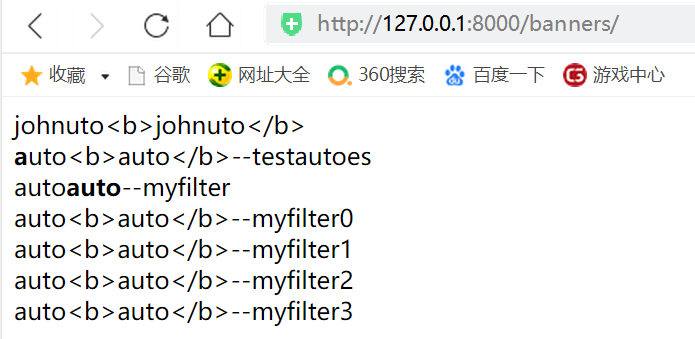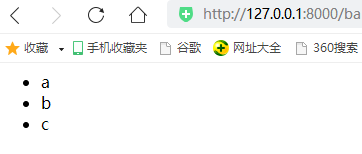配置
(1)最常见的放置自定义Tag和Filter的地方是在Django的app下。当一个app被添加到settings.py的INSTALLED_APPS 后,任何在它下面的合法位置将自动的可在templates中被调用。合法位置就是在app下的templatetags子文件夹下,但不要忘记添加init.py文件来表明它是个包。
自定义的tag或者filter就在templatetag文件夹下的py文件中,在template中调用的是该py文件的名字,比如
app名字是polls,tags/filter在poll_extras.py中:
polls/
__init__.py
models.py
templatetags/
__init__.py
poll_extras.py
views.py
在template中这样加载定义在poll_extras.py中的tags/filters:
{% load poll_extras %}
包含定制的tags/filters的app必须在INSTALLED_APPS,并且{% load ... %}也是在INSTALLED_APPS从上往下搜索。
(2)当然放置Tag和Filter的文件也不一定非得在app中,可以在project的任何地方,但是这种情况下,需要在DjangoTemplates的libraries中注册,比如,将放置tag/filters的文件testcommon.py放置在工程的新建common文件夹下。

然后在settings.py的TEMPLATE中注册该文件,需要注意的是在templates中load的是‘commonfile'。
TEMPLATES = [
{
'BACKEND': 'django.template.backends.django.DjangoTemplates',
'DIRS': [TEMPLATE_DIR],
'APP_DIRS': True,
'OPTIONS': {
# 'string_if_invalid':InvalidTemplateVariable('%s'),
# 'autoescape':False,
'context_processors': [
'django.template.context_processors.debug',
'django.template.context_processors.request',
'django.contrib.auth.context_processors.auth',
'django.contrib.messages.context_processors.messages',
'banners.processors.onsale',
],
'libraries':{'commonfile':'testBegin.common.testcommon'},
},
},
]
testcommon.py中定义commonfilter:
from django import template
from django.utils.html import escape
from django.utils.safestring import mark_safe
register=template.Library()
@register.filter(needs_autoescape=True)
def commonfilter(value,autoescape=True):
if autoescape:
value=escape(value)
result='<b>%s</b>'%value
return mark_safe(result)
最后在template中调用:
{% load commonfile %}
{{ coffee|commonfilter }} #其中coffee变量为'mocamoca'
那能不能像built-in filter一样,不用每次都声明{% load custom filter %}?可以的,只需要在settings.py中的'TEMPLATES'的'OPTIONS'字段内加入'builtins':['location of files containing filter'],比如:
TEMPLATES = [
{
'BACKEND': 'django.template.backends.django.DjangoTemplates',
'DIRS': [TEMPLATE_DIR],
'APP_DIRS': True,
'OPTIONS': {
# 'string_if_invalid':InvalidTemplateVariable('%s'),
# 'autoescape':False,
'context_processors': [
'django.template.context_processors.debug',
'django.template.context_processors.request',
'django.contrib.auth.context_processors.auth',
'django.contrib.messages.context_processors.messages',
'banners.processors.onsale',
],
'builtins':['testBegin.common.testcommon'],
},
},
]
写自定义的模板filter
自定义filter是有1个或者2个参数的Python函数:
-
输入变量的值(不一定必须是string)
-
值的参数,可以有默认值
比如,{{ var|foo:'bar' }},foo被掺入了变量var和参数'bar'。
下面是个简单的例子:
#bannerTags.py from django import template register=template.Library() @register.filter() def john(value,arg): return value.replace(arg,'john'){% load bannerTags %} {{ coffee|john:'m' }}coffee的值为'macomaco',
@register.filter可以没有参数,直接用@register.filter来装饰,也可以有参数,起到特定的功能:
- name:默认的filter的名字就是函数名字,而name参数可以改变filter的名字
如
@register.filter(name='cutname')
def cut(value, arg):
return value.replace(arg, '')
{{ coffee|cutname:'m' }}
- 此外,还有
is_safe,needs_autoscape,expects_localtime.
字符期望的Filter(Template filters that expect strings)
django.template.defaultfilters.stringfilter()
在上面的例子中,如果coffee的值是11,则会报错:

解决这个只需要再加层装饰器就可以了:
from django import template
from django.template.defaultfilters import stringfilter
register=template.Library()
@register.filter
@stringfilter
def john(value,arg):
return value.replace(arg,'john')
可以发现已经没有报错了:

Filter 和 auto-escaping
from django import template
from django.template.defaultfilters import stringfilter
register=template.Library()
from django.utils.html import conditional_escape
from django.utils.safestring import mark_safe
@register.filter
@stringfilter
def john(value,arg):
return value.replace(arg,'john')
@register.filter(is_safe=True)
def myfilter0(value):
return value
@register.filter()
def myfilter(value):
return mark_safe(value)
@register.filter(needs_autoescape=True)
def testautoes(text,autoescape=True):
first,other=text[0],text[1:]
if autoescape:
esc=conditional_escape
else:
esc=lambda x:x
result='<b>%s</b>%s' % (esc(first),esc(other))
return mark_safe(result)
# return result
@register.filter()
def myfilter1(value):
value=conditional_escape(value)
return mark_safe(value)
@register.filter()
def myfilter2(value):
value=conditional_escape(value)
return value
@register.filter()
def myfilter3(value):
return value
{% load bannerTags %}
{{ coffee|john:'a' }}
<br>
{{ coffee|testautoes }}--testautoes
<br>
{{ coffee|myfilter }}--myfilter
<br>
{{ coffee|myfilter0 }}--myfilter0
<br>
{{ coffee|myfilter1 }}--myfilter1
<br>
{{ coffee|myfilter2 }}--myfilter2
<br>
{{ coffee|myfilter3 }}--myfilter3

当在settings.py的Templates的'OPTIONS'添加autoexcape:False时,

从这个例子可以看出几点:
- 自定义filter的函数大多都受总的
autoescape设定(即settings.py中关于autoescape)的影响,如果总的autoescape被设定为False,则含有”不安全“的符号如'<,>,'将不被转义,但是当通过conditional_escape处理后,则仍然被转义,具体表现为上图'myfilter1'和'myfilter2' - 当总的
autoescape是True(默认情况),大多含有”不安全“的符号,都要进行转义,但是通过mark_safe而没有通过conditional_escape的处理,将直接被渲染。
写自定义Tags
Tags 比Filter更复杂,因为tags可以做任何事情,Django提供了很多快捷方式来使得写tags更方便。
Simple tags
django.template.Library.simple_tag()
很多模板tag有很多参数,字符串或者模板变量,然后仅仅基于输入的参数进行一些操作,然后返回结果。比如,‘current_time'可以接受一个字符串模板,返回时间的格式化的字符。
为了简化这种tag的创建过程,Django提供了个帮助函数,simple_tag,这个函数是django.template.Library的方法,它的接受任意的参数,用render函数包裹该函数,所以它就是起了一个装饰器的作用。
#bannerTags.py
import datetime
from django import template
register = template.Library()
@register.simple_tag
def current_time(format_string):
return datetime.datetime.now().strftime(format_string)
{% load bannerTags %}
{% current_time ' %Y/ %m/ %d' as tim %}
{{tim}}

不像其他tag的用法,如果是autoescape模式,simple_tag就会将它的输出再输入conditional_escape()中,来保证正确的HTML,来免于XSS攻击。
如果十分确定没有XSS攻击代码,则可以用mark_safe(),而对于创建小的HTML代码块,建议用format_html(),而不是mark_safe().
-
如果需要重命名,老规矩,就像Filter一样,在
register.simple_tag()中传入name即可。 -
如果需要接受任意数量的positional argument或者keyword arguments,比如:
@register.simple_tag def my_tag(a, b, *args, **kwargs): warning = kwargs['warning'] profile = kwargs['profile'] ... return ...在模板中,任意的参数,被空格分隔,就会被传入tag中。与python类似的是,对于keyword argument,用 等于号 '='来表示,而keyword argument跟在python中的类似,也必须放在position arguments之后。
{% my_tag 123 "abcd" book.title warning=message|lower profile=user.profile %} -
如果不直接输出tag的结果,而是将该结果储存起来,也是可以的。通过
as就可以达到这个效果,比如:{% current_time "%Y-%m-%d %I:%M %p" as the_time %} <p>The time is {{ the_time }}.</p>Inclusion tags
django.template.Library.inclusion_tag()另一种常见的类型是通过render其他的模板来展示数据的,这种tags被称为'inclusion tags‘。
写法步骤如下:
(1)首先定义一个函数及其输入参数,然后返回一个字典,该字典将被当做一个template context传入被rendered 的其他模板。
#testcommon.py
def show_results(strings):
choices=strings.split('s')
return {'choices':choices}
(2)定义被rendered的其他模板,其位置必须能被搜索到。
# results.html
<ul>
{% for alpha in choices %}
{% if alpha %}
<li> {{ alpha }}</li>
{% endif %}
{% endfor %}
</ul>
(3)通过调用inclusion_tag来创建,和注册一个inclusion tag。
#testcommon.py
@register.inclusion_tag('banners/results.html')
def show_results(strings):
choices=strings.split('s')
return {'choices':choices}
(4)在模板中使用该tag。
#test.html
{% show_results coffee %}
其路由为:
urlpatterns=[
url(r'^method',views.method,name='method'),
url(r'^$',TemplateView.as_view(template_name='banners/test.html',extra_context={'coffee':'moscamsocas'}),name='index'),
]
运行:

-
也可以在模板中直接传字符串:
#test.html {% show_results 'asbscs' %}

还有一种等效的方法是:
#testcommon.py
from django.template.loader import get_template
t=get_template('banners/results.html')
register.inclusion_tag(t)(show_results)
可以看到,本质上与第一种方法是一样的,只不过是显式的找到html然后传递给register.inclusion_tag,然后再传入show_results,这个过程本身就是装饰器的显式表达。
有时候,inclusion tags需要将大量的参数传入,这时候对于使用tags的人来说非常痛苦,还要记住参数顺序。为解决这种问题,Django为inclusion tag提供了take_context选项,当表明了它,并设置为True,使用模板时,可以不需要参数,相应的python function只需要传入一个参数context,从而达到直接将被调用的template的context_dict传入tag function,并通过tag function 传入被rendered的Html。
比如:
@register.inclusion_tag('banners/results.html',takes_context=True)
def show_results(context):
choices=context['coffee'].split('s')
return {'coffee':choices }
#被call的test.html
{% show_results %}
#被rendered的html,可见coffee被传入
<ul>
{% for alpha in coffee %}
{% if alpha %}
<li> {{ alpha }}</li>
{% endif %}
{% endfor %}
</ul>

最后,inclusion_tag也可以接受任意数量的position argument和keyword argument:
如:
@register.inclusion_tag('my_template.html')
def my_tag(a, b, *args, **kwargs):
warning = kwargs['warning']
profile = kwargs['profile']
...
return ...
{% my_tag 123 "abcd" book.title warning=message|lower profile=user.profile %}

